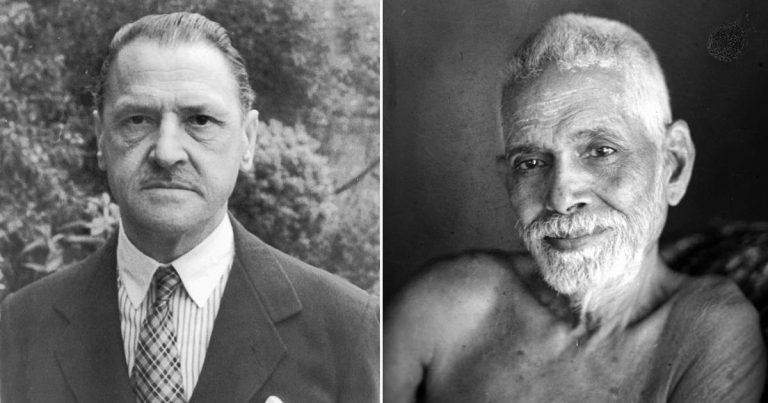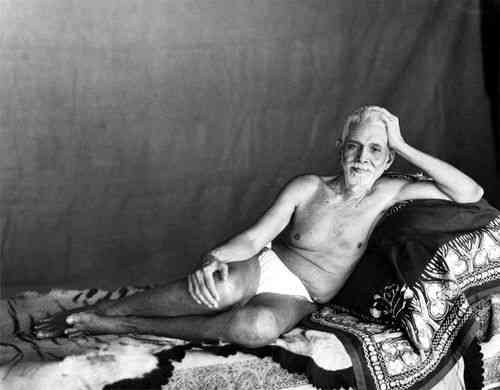
Ramana Maharshi was the inspiration for a major character in Maugham’s 1944 novel The Razor’s Edge. The book is about an American pilot who decides to seek spirituality after the First World War leaves him scarred and traumatized.
Ajay Kamalakaran
For several decades, Hindu sage Ramana Maharishi’s ashram in the temple town of Tiruvanamalai in Tamil Nadu has been a magnet for people from around the world seeking spiritual solace and fulfilment. During his lifetime (1879-1950), the ashram was a lodestar that drew a fair share of successful Westerners. Among them once was Somerset Maugham.
In the 1930s, the English novelist and playwright, who had established himself as a literary presence, developed a curiosity for Indian spiritual thoughts and practices. Spurred by this fascination, he embarked on a journey in 1936 to India, where he was treated like a celebrity and offered the finest hospitality by the maharajas.
“When they had discovered that I had not come to shoot a tiger, or to sell anything, nor especially to see the Taj Mahal, the Caves of Ajanta or the temple of Madura, but to meet scholars, writers and artists, religious workers and devotees, they were surprised and pleased,” Maugham wrote in an essay titled The Saint that was published in 1958 as a part of a collection called Points of View. He was “something new in their experience,” which helped him meet a number of people who were of “absorbing interest” to him.
In Madras, he came across a group of individuals that found his interest in Indian religious teachers fascinating. “I told them about the holy men who had suffered me to visit them, and they immediately proposed to take me to see a Swami who was the most celebrated and most revered then in India,” Maugham wrote. “They called him the Maharishi. Pilgrims from far and near went to him for instruction, advice and consolation in their troubles.” The writer happily agreed to visit Ramana Maharshi.
An unusual meeting
In January 1938, when Maugham undertook the nearly 200-kilometre journey from Madras to the pilgrim town, most of the road network was basic at best. “After a dull hot drive, along a dusty, bumpy road, bumpy because the heavy wheels of the ox wagons had left deep ruts in it, we reached the Ashram,” he wrote. While waiting for the Maharishi, the group decided to eat a packed lunch they had taken from Madras.
“Suddenly I fainted dead away,” Maugham wrote. “I was carried on to a hut and laid on a pallet bed. I do not know how long I remained unconscious, but presently I recovered. I felt however too ill to move.”

When Ramana Maharshi was told that the English writer had fainted and could not come to the main hall where the sage met visitors, he went to the hut himself.
“The Maharshi was of average height for an Indian, of a dark honey color with close-cropped white hair and a close-cropped white beard,” Maugham wrote in his diary after returning to Madras. “He was plump rather than stout. Though he wore nothing but an exiguous loincloth he looked neat, very clean and almost dapper. He had a slight limp, and he walked slowly, leant on a stick. His mouth was somewhat large, with thickish lips and the whites of his eyes were bloodshot. He bore himself with naturalness and at the same time with dignity. His mien was cheerful, smiling, and polite; he did not give the impression of a scholar, but rather of a sweet-natured old peasant. He uttered a few words of cordial greeting and sat on the ground not far from the pallet on which I lay.”
In the hut, the sage looked at the writer’s face for a few minutes with what Maugham described as a “gentle benignity”. He then fixed his gaze over his shoulder. “His body was absolutely still, but now and then one of his feet tapped lightly on the earthen floor,” Maugham wrote. “He remained thus, motionless, for perhaps a quarter of an hour; and they told me later that he was concentrating in meditation upon me.”
Ramana Maharshi asked Maugham if he had any question or wanted to say something, to which the writer, who was still feeling sick, said no. “Silence is also conversation,” the sage replied and then resumed his meditation for another 15 minutes before leaving the hut.
Maugham slowly managed to get his strength back. “I do not know whether it was the consequence of the rest or of the Swami’s meditation, but I certainly felt much better and in a little while I was well enough to go into the hall where he sat by day and slept at night,” he wrote. The writer stayed in the main hall for a while and observed the sage and the visitors.
Maugham noted that Ramana Maharshi spoke to a few visitors and then asked them to withdraw before going into a deep state of meditation.
“The Swami entered that blissful state of meditation on the infinite which is called Samadhi,” Maugham wrote. “A little shiver seemed to pass through those present. The silence was intense and impressive. You felt that something strange was taking place that made you inclined to hold your breath.”
In his essay, Maugham added that his fainting led to the circulation of many rumors. Some said the writer fainted because of the awe that overcame him at the prospect of going into the presence of such a holy person, while others said the influence of Ramana Maharshi on Maugham even before he saw him caused the writer to be “rapt for a while in the infinite”. The writer tried to avoid saying anything that would offend the sage’s followers. “In point of fact that was neither the first nor the last time that I have fainted,” he noted in his essay. “Doctors tell me that it is owing to an irritability of the solar plexus which pressed my diaphragm against my heart.”
Fond memories
It was widely believed that Maugham was an agnostic, but the meeting with Ramana Maharshi made him read in greater detail about Hindu philosophies and beliefs. The essay The Saint is not as well-known as some of the writer’s great works of fiction, but it shows he developed a fine understanding of the various belief systems that came under the Hindu umbrella.
In the 1958 essay Maugham went on to write about the Upanishads and gave readers a detailed explanation of the concept of Brahman and Atman and Adi Sankara’s philosophy.
Referring to the rumors about his fainting, he wrote, “How do I know, they ask me, that I was not rapt in the infinite? To that I do not know the answer, and the only thing I can say, but refrain from saying for fear it will offend them, is that if it was, the infinite is an absolute blank.” Maugham added that the idea was “not so bizarre as at first glance” when one remembered the Hindu belief “that in deep, dreamless sleep consciousness remains and the soul is then united with the infinite reality which is Brahman”.
He added a comprehensive biography of Ramana Maharshi in the essay, calling him an “extraordinary man”. He narrates an anecdote of a group of Dalit devotees coming to meet Ramana Maharshi. To the sage caste “signified nothing”, Maugham wrote, but the Dalit devotees were hesitant to seek permission to see him since they were worried about being shunned. As it happened, they were welcomed to see Ramana Maharshi. “The party entered and prostrated before the Maharishi,” Maugham wrote. “His look dwelt upon for them about ten minutes and grace was vouchsafed them.” A devotee told Maugham that many rich and famous people fell at the sage’s feet but did not receive such a blessing from him.
Maugham also appreciated the sage’s love for animals such as dogs. He wrote, “The Brahmins considered dogs unholy, polluting, and avoided their contact. The Maharshi regarded them as fellow-ascetics who had come to atone for the error of their past lives in his proximity. He saw that they were kept clean and comfortable, and lovingly called them the children of the Ashram.” He added that the dogs understood the instructions the sage gave them.
Inspired words
Ramana Maharshi was the inspiration for a major character in Maugham’s 1944 novel The Razor’s Edge. The book is about an American pilot who decides to seek spirituality after the First World War leaves him scarred and traumatized. The title of the novel came from a verse in the Katha Upanishad which is translated and paraphrased in the book’s epigraph: “The sharp edge of a razor is difficult to pass over; thus the wise say the path to Salvation is hard.”
In the novel, the protagonist Larry Darrell meets Sri Ganesha, the sage inspired by Ramana Maharshi, in Trivandrum. Recalling his meeting later to the narrator, Darrell says:
‘We’ve read all about the saints. St Francis, St John of the Cross, but that was hundreds of years ago. I never thought it was possible to meet one who was alive now. From the first time I saw him I never doubted that he was a saint. It was a wonderful experience.’
‘And what did you gain from it?’
‘Peace.’ He said casually with a light smile.
The novel generated renewed interest in Indian philosophy in the West and was adapted twice into films. It was Maugham’s first attempt to explain the Adi Sankara’s Advaita Vedanta to an English and American audience. His 1958 essay went into far greater detail and could easily serve as a guide to those not familiar with Indian philosophy.
___________________
Ajay Kamalakaran is a writer and independent journalist, based in Mumbai. He is a Kalpalata Fellow for History & Heritage Writings for 2022.
Courtesy: Scroll